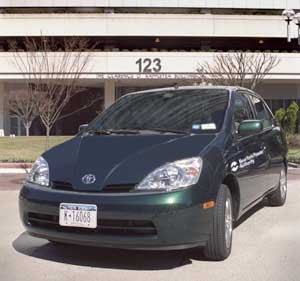 Battery electric vehicles (EVs) run on electricity stored in batteries and have an electric motor rather than a gasoline engine. EVs are often confused with conventional hybrid electric vehicles which combine an internal combustion engine with a battery and electric motor. However EVs are zero emission cars because they have no internal combustion engine so they have no tailpipe exhaust and no evaporative emissions from the fuel system.
Battery electric vehicles (EVs) run on electricity stored in batteries and have an electric motor rather than a gasoline engine. EVs are often confused with conventional hybrid electric vehicles which combine an internal combustion engine with a battery and electric motor. However EVs are zero emission cars because they have no internal combustion engine so they have no tailpipe exhaust and no evaporative emissions from the fuel system.Over the years, manufacturers have developed a wide range of EV types that include:
- Neighborhood electric vehicles (NEVs) that can be used for short trips around town.
- City EVs with 50-75 miles range also for around town use.
- Full function EVs which can go up to 80 miles an hour and have a longer range.
How it Work:
An EV has three main components: the batteries, the electric motor controller, and the electric motor. The controller converts direct current (DC) from the batteries to alternating current (AC) for the motor. The most common battery types available are, Nickel metal hydride, Lithium Ion, and Lead acid. To recharge the batteries, there is a charger on the car which takes the electricity from a power source (ultimately the power plant) and converts the current from AC to DC for the battery.
Benefits
Battery electric vehicles will always have a Global Warming Score of 10 and Smog Score of 10 on their Environmental Performance Label. This is even taking into account the power plant emissions from making the electricity to charge the cars. Here are more battery EV benefits:
An EV has three main components: the batteries, the electric motor controller, and the electric motor. The controller converts direct current (DC) from the batteries to alternating current (AC) for the motor. The most common battery types available are, Nickel metal hydride, Lithium Ion, and Lead acid. To recharge the batteries, there is a charger on the car which takes the electricity from a power source (ultimately the power plant) and converts the current from AC to DC for the battery.
Benefits
Battery electric vehicles will always have a Global Warming Score of 10 and Smog Score of 10 on their Environmental Performance Label. This is even taking into account the power plant emissions from making the electricity to charge the cars. Here are more battery EV benefits:
- No tailpipe exhaust
- No evaporative emissions
- No emissions system which can degrade or fail with time
- No emissions from the refining of fuel and service stations
- Reduced greenhouse gas emissions
- Reduced exposure to toxic air contaminants such as benzene when refueling with gasoline
- Reduced oil consumption and dependence on imported oil
- When factoring in power plant emissions - EVs are 90% cleaner than the average new gasoline vehicle.
- EVs are 3 ½ to 4 times more efficient than their gasoline counterparts.
Safety
EVs meet all federal motor vehicle safety requirements. The batteries are sealed and all high-voltage circuits are protected from accidental contact. High-voltage circuits are color-coded orange and posted with warnings to advise of their presence. These vehicles pose no additional risks over a conventional vehicle.
EVs meet all federal motor vehicle safety requirements. The batteries are sealed and all high-voltage circuits are protected from accidental contact. High-voltage circuits are color-coded orange and posted with warnings to advise of their presence. These vehicles pose no additional risks over a conventional vehicle.
No comments:
Post a Comment